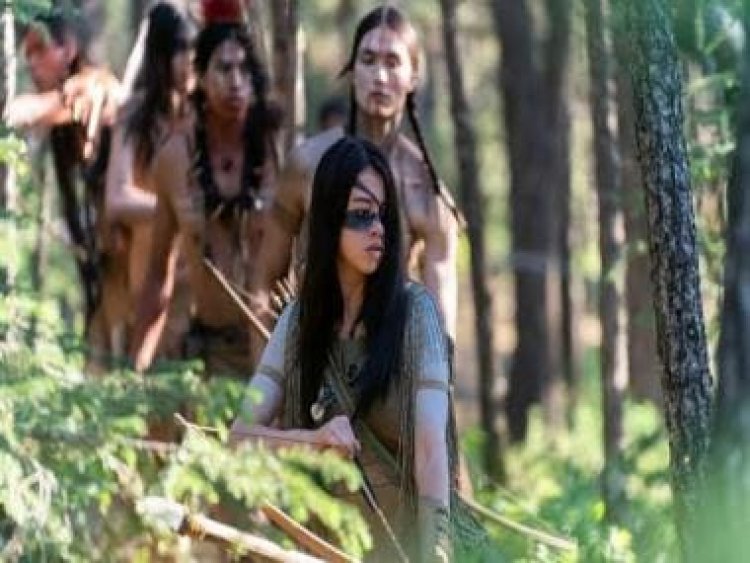Prey review: Predator prequel is an anti-colonial allegory wrapped in one lean and mean thriller
Prey review: Predator prequel is an anti-colonial allegory wrapped in one lean and mean thriller

So far, the crab-faced, dread-locked extra-terrestrial we know as the Predator has gone head-to-head with the ex-California governor, one half of Lethal Weapon, the Pianist, and the Corinthian. Let’s not forget those two Alien cross-over movies where the Xenomorphs and facehuggers presented quite the challenge – to say the least. Now, a prequel to all those movies pits the Predator against its most dauntless and resourceful adversary yet: a young 18th-century Comanche warrior with a point to prove to her tribe. By pitting these two challengers in a fight of — and for — their lives, Prey serves a terrific who’s-hunting-whom fable.

What the Predator movies have always banked on is the intrigue of a mismatched contest. Tables are turned: Humans are the underdog, ill-equipped to deal with the well-equipped alien threat. The joy lies in watching our kind punch above their weight with sheer force of will. The Predator, in Prey, is armed with a heat sensor, an invisibility cloak, a laser-guided crossbow, a shield gauntlet and wrist blades. If the human adversaries of previous movies at least had guns and grenades, our Comanche heroine Naru (Amber Midthunder) must make do with a tethered tomahawk, a loyal dog and the strength of her wits. In spite of the tech disparity, what a contest it sure proves to be. As the camera tracks this contest through the jungles and plains of North America with a catlike mobility, director Dan Trachtenberg stages some invigorating set pieces. Prey is not too different from his feature debut 10 Cloverfield Lane in terms of how he builds a sophisticated genre outing in an existing sandbox and envisions a wholly original story without losing the tone and texture of its predecessor.
Who knew the future of the Predator franchise lay in its past? Prey shows the way forward by winding back the clock to 1719. A Predator lands on its species’ favourite game reserve: Earth. It is possibly the first one to make the trip but obviously not the last. Being a hunting trip, it kills its way up the food chain to establish its alpha status. In a sequence early in the film, an ant is eaten by a mouse, which is then devoured by a snake, which is then impaled by the Predator’s wrist blades. In another sequence, a wolf chases down a hare, only to be beheaded and turned into a trophy in the alien visitor’s growing collection. All this is of course prelude to the battle against the apex predator in humankind. Naru’s journey to find her own identity is set up in parallel at a roomy pace to allow their eventual run-in to take form more organically.

It is not just the Predator that Naru runs into but also a party of French fur trappers. Given there is an extra-terrestrial and a bunch of snarly Europeans clashing against an Indigenous woman in her own native land, Prey functions as an allegory about the invisible and visible horrors of colonialism. Even before we first catch sight of the French hunters, the spectre of colonialism is rendered visible in a devastating scene where Naru happens upon a field full of skinned and rotting corpses of bison. There is a ruthlessness to this mass slaughter, akin to the Predator killing its way up the food chain or the rich American dentists travelling to Africa to hunt big game, all driven by a desire to prove their supremacy over all things living.
For the Comanche, hunting is merely about survival, not sport. For Naru, her only desire is to complete the “kühtaamia,” a rite of passage that requires a hunter to hunt something that will hunt him or her back. Not happy with the station of a caretaker traditionally assigned to Comanche women, she wishes to become a warrior like her brother Taabe (Dakota Beavers). When her mother Aruka (Michelle Thrush) questions her motives, she explains, “Because everybody thinks I can’t.” On the hunt, Naru discovers unnatural tracks and slaughtered animals, suspecting it to be the work of an unfamiliar predator. The rest of the tribe though refuse to believe her and insist it’s just a cougar — until an ambush makes them reconsider.
Keeping us hooked throughout the 90-odd minutes is Midthunder. She may not be built like a tank like Arnold Schwarzenegger, but she finds strength in Naru’s internal drive, reflected in her eyes narrowing with steely determination. The fierceness she lends to the character adds to the rhythm of the action. The primal fear is never more real than in a sequence where Naru is chased after by an angry grizzly bear. In perhaps the most thrilling sequence, she is nearly devoured whole not by any predator, but quicksand. The final battle vs the Predator is a well-mounted exhibition of strategic criss-crossing and angular movements. Rather than let the formidable stature of her otherworldly opponent unsettle her, Naru employs her savvy and agility to her advantage, making her one of the most memorable final girls and action heroines in recent years.

For the most part, Trachtenberg is mindful of how choreography and geography are vital to an action sequence. His DP Jeff Cutter also uses focus racks to thrilling results during the ambush sequence. Where the movie is found wanting is the night-time lighting, which fails to capture the grandeur of its landscapes managed so well in the daytime. Some poor choices in this regard causes us to lose our bearings in an otherwise faultless climactic showdown.
Neither the iron foot traps strewn across the forest nor the 18th century muzzleloaders of the French colonisers prove enough to take out the far more technologically advanced Predator in the end. Nuru uses what she knows about healing and hunting and what she learns about her enemy to gain the upper hand. She consumes the medicinal herbs to lower her body temperature and hide herself from its heat sensors. Then, she weakens its defences, sets a trap for the handicapped creature, and uses its weapon against itself. It’s a strategy right out of Sun Tzu’s The Art of War: “Know thy enemy and know yourself; in a hundred battles, you will never be defeated.”
Prey is now streaming on Disney+ Hotstar.
Prahlad Srihari is a film and music writer based in Bengaluru.
Read all the Latest News, Trending News, Cricket News, Bollywood News, India News and Entertainment News here. Follow us on Facebook, Twitter and Instagram.
What's Your Reaction?



























































